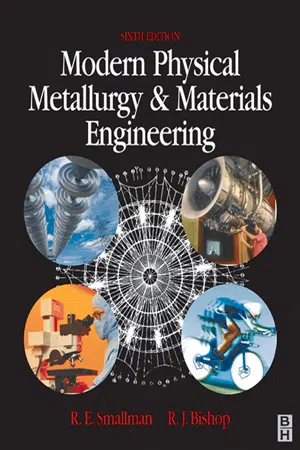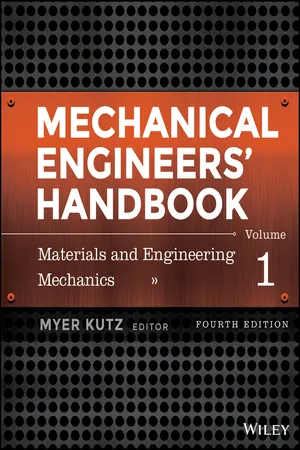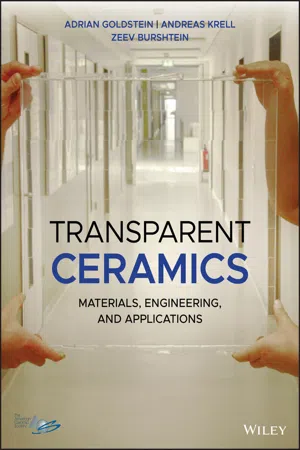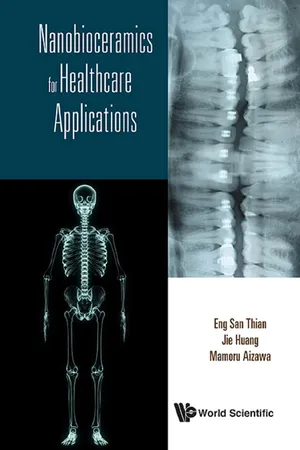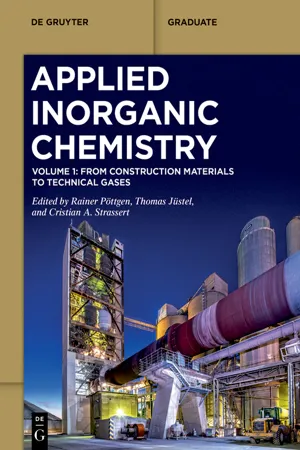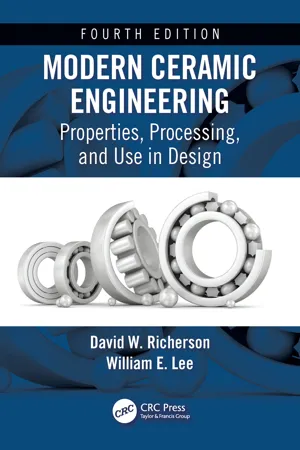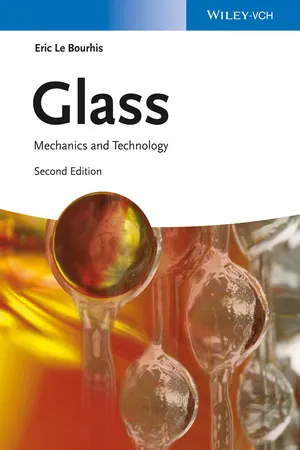Technology & Engineering
Glass Ceramics
Glass ceramics are a type of material that combines the properties of glass and ceramics. They are produced by controlled crystallization of glass, resulting in a material with high strength, thermal resistance, and transparency. Glass ceramics find applications in various fields, including cookware, dental materials, and electronics, due to their unique combination of properties.
Written by Perlego with AI-assistance
Related key terms
Related key terms
1 of 4
Related key terms
1 of 3
9 Key excerpts on "Glass Ceramics"
- R. E. Smallman, R J Bishop(Authors)
- 1999(Publication Date)
- Butterworth-Heinemann(Publisher)
Chapter 10Ceramics and glasses
10.1 Classification of ceramics
The term ceramic, in its modern context, covers an extremely broad range of inorganic materials; they contain non-metallic and metallic elements and are produced by a wide variety of manufacturing techniques. Traditionally, ceramics are moulded from silicate minerals, such as clays, dried and fired at temperatures of 1200–1800°C to give a hard finish. Thus we can readily see that the original Greek word keramos , meaning ‘burned stuff’ or ‘kiln-fired material’, has long been directly appropriate. Modern ceramics, however, are often made by processes that do not involve a kiln-firing step (e.g. hot-pressing, reaction-sintering, glass-devitrification, etc.). Although ceramics are sometimes said to be non-metallic in character, this simple distinction from metals and alloys has become increasingly inadequate and arbitrary as new ceramics with unusual properties are developed and come into use.Ceramics may be generally classified, according to type or function, in various ways. In industrial terms, they may be listed as pottery, heavy clay products (bricks, earthenware pipes, etc.), refractories (firebricks, silica, alumina, basic, neutral), cement and concrete, glasses and vitreous enamels, and engineering (technical, fine) ceramics. Members of the final group are capable of very high strength and hardness, exceptional chemical stability and can be manufactured to very close dimensional tolerances. These will be our prime concern. Their introduction as engineering components in recent years has been based upon considerable scientific effort and has revolutionized engineering design practice. In general, the development of engineering ceramics has been stimulated by the drive towards higher, more energy-efficient, process temperatures and foreseeable shortages of strategic minerals. In contrast to traditional ceramics, which use naturally-occurring and, inevitably, rather variable minerals, the new generation of engineering ceramics depends upon the availability of purified and synthesized materials and upon close microstructural control during processing. Ceramics are subject to variability in their properties and statistical concepts often need to be incorporated into design procedures for stressed components. Design must recognize the inherent brittleness, or low resistance to crack propagation, and modify, if necessary, the mode of failure. Ceramics, because of their unique properties, show great promise as engineering materials but, in practice, their production on a commercial scale in specified forms with repeatable properties is often beset with many problems.- eBook - ePub
Mechanical Engineers' Handbook, Volume 1
Materials and Engineering Mechanics
- Myer Kutz, Myer Kutz(Authors)
- 2015(Publication Date)
- Wiley(Publisher)
Chapter 12 Overview of Ceramic Materials, Design, and Application R. Nathan Katz Department of Mechanical Engineering, Worcester Polytechnic Institute, Worcester, Massachusetts Revised for this edition.- 1 INTRODUCTION
- 2 PROCESSING OF ADVANCED CERAMICS
- 3 BRITTLENESS AND BRITTLE MATERIALS DESIGN
- 4 APPLICATIONS
- 4.1 Ceramics in Wear Applications
- 4.2 Thermostructural Applications
- 4.3 Corrosion Resistance
- 4.4 Passive Electronics
- 4.5 Piezoceramics
- 4.6 Transparencies
- 5 INFORMATION SOURCES
- 5.1 Manufacturers and Suppliers
- 5.2 Data
- 5.3 Standards, Test Methods, and Handbooks
- 6 FUTURE TRENDS
- REFERENCES
1 Introduction
Engineering ceramics possess unique combinations of physical, chemical, electrical, optical, and mechanical properties. Utilizing the gains in basic materials science understanding and advances in processing technology accrued over the past half century, it is now frequently possible to custom tailor the chemistry, phase content, and microstructure to optimize application-specific combinations of properties in ceramics (which include glasses, single crystals, and coatings technologies, in addition to bulk polycrystalline materials). This capability in turn has led to many important, new applications of these materials. Indeed, in many of these applications the new ceramics and glasses are the key enabling technology.Ceramics include materials that have the highest melting points, highest elastic moduli, highest hardness, highest particulate erosion resistance, highest thermal conductivity, highest optical transparency, lowest thermal expansion, and lowest chemical reactivity known. Counterbalancing these beneficial factors are brittle behavior and vulnerability to thermal shock and impact. Major progress has been made in learning how to design to mitigate the brittleness and other undesirable behaviors associated with ceramics and glasses. Consequently, many exciting new applications for these materials have emerged over the past several decades. Among the major commercial applications for these materials are: - eBook - ePub
Transparent Ceramics
Materials, Engineering, and Applications
- Adrian Goldstein, Andreas Krell, Zeev Burshtein(Authors)
- 2020(Publication Date)
- Wiley-American Ceramic Society(Publisher)
The amount of crystallites in such systems, while able to influence optical properties, is too low to alter significantly the glassy structure. Such materials are basically glasses, a subject we refrain from addressing thoroughly in this book. However, a type of material that while also having a glass matrix includes higher amounts of crystalline phases than the materials discussed earlier – high enough to significantly influence also non optical properties – called glass–ceramic, will preoccupy us. Experiments toward development of glass–ceramics actually started more than 200 years by de Reaumur [R11]. During the 1950s, that new class of materials was successfully developed [ S1, [S66] – S60 ]. Objects are considered glass–ceramic when the product of the initial fabrication stage appears as a bulk (compact) or a powdered glass. This state is then altered by controlled crystallization, which converts the part into a state in which crystalline phases constitute a considerably large fraction (20 − 75%) to significantly modify the mechanical, thermal, and chemical properties of the initial glass. Let us underline that, in best cases, the crystalline part may approach 100%. The final products in such best cases are similar, in appearance and properties, to those fabricated by powder sintering. These hybrid transparent solids, the glass–ceramics, have to be considered, for obvious reasons, by both glass makers and ceramists; therefore, they are discussed also in this book. Discovery of the practical usefulness of glass–ceramics was accidental, much like those of penicillin or the radioactivity. As always, it required an observer capable of understanding the implications of the accidentally observed facts. Thus, during experiments regarding metal colloids precipitation in glass, S.D - eBook - ePub
- Eng San Thian, Jie Huang, Mamoru Aizawa(Authors)
- 2016(Publication Date)
- WSPC (EUROPE)(Publisher)
® A–W displayed higher mechanical strength than cortical bone. Recent progress in the development of bioactive glass-ceramics was then presented. Many research studies have focused on improving the biological and mechanical properties of glass-ceramics by controlling their composition and micro-structures as well as by fabricating hybrids with polymers. Finally, the application of glass-ceramics in other fields, i.e., cancer and dental therapy, was briefly presented. Glass-ceramics have been one of the most useful biomedical materials developed since the early development of bioactive ceramic materials and they are presently generating much interest in the bioceramic field.8.6 Future Perspectives
Glass-ceramics are composites constituting of crystal and glass phases. The crystal phase, crystal size, composition of the glass phase, and ratio of the crystal and glass phases can be controlled. Accordingly, the physicochemical, mechanical, and biological properties of glass-ceramics can be tailored to meet the requirements of different applications. Glass-ceramics have been mainly used in the reconstruction of hard tissues of bone and teeth. Additionally, they have high potential in other medical applications as various functionalities can be exhibited by tailoring the nature and composition of the crystalline phase precipitated in the glass matrix.References
1. Hench LL, Splinter RJ, Allen WC, Greenlee TK. Bonding mechanisms at the interface of ceramic prosthetic materials. J Biomed Mater Res Symp 1971; 2:117–141.2. Kokubo T. Surface chemistry of bioactive glass-ceramics. J Non-Cryst Solids 1990; 120:138–151.3. Kokubo T. Bioactive Glass Ceramics: Properties and applications. Biomaterials 1991; 12:155–163.4. Neo M, Kotani S, Nakamura T, Yamamuro T, Ohtsuki C, Kokubo T, Bando Y. A comparative study of ultrastructures of the interfaces between four kinds of surface-active ceramic and bone. J Biomed Mater Res 1992; 26:1419–1432.5. Kokubo T, Kushitani H, Sakka S, Kitsugi T, Yamamuro T. Solutions able to reproduce in vivo surface-structure changes in bioactive glass-ceramic A–W. J Biomed Mater Res - eBook - ePub
Functional Materials
Preparation, Processing and Applications
- S. Banerjee, A.K. Tyagi, A. K. Tyagi(Authors)
- 2011(Publication Date)
- Elsevier(Publisher)
Such ordering is termed short-range order (SRO). The properties of the glass depend greatly upon the SRO. This is, in turn, influenced by the nature of the glass melt, its processing and the presence of additives [4]. The presence of additives also modifies the properties of the glasses, allowing the establishment of new functionalities. The functionality can be optical, thermo-physical, chemical, biological, tribological, etc. or a combination of these. In addition, glasses can be crystallized to yield glass-ceramics. These are a kind of polycrystalline material formed by controlled crystallization of the parent glasses [5]. Glass-ceramics offer numerous advantages compared with parent glasses such as improved thermo-physical properties, higher strength, wear resistance, often making them better suited than glasses for various applications. In this chapter, we shall discuss the preparation of glasses, kinetics of crystallization and various specific functionalities that are possible using glasses and glass-ceramics. In several ways, glasses and more recently glass-ceramics have been able to combine several qualities that include transparency, chemically inertness, environmental compatibility and high strength. These properties could be inherent to the glass itself such as photo-chromicity and transparency, or could be a result of modifications in structure and microstructure arising from processing techniques. The example of the latter is bullet-proof glass, which comprises several layers of laminated glass and polymers. Although other classes of material can match or even surpass glasses (and glass-ceramics) in individual properties, it would be difficult to find a material that performs as well as glass over a range of functionalities at a reasonable cost. As an example, polymeric compounds can match the transparency of glass but cannot match its durability or function at high temperature [6] - eBook - ePub
- Rainer Pöttgen, Thomas Jüstel, Cristian A. Strassert, Rainer Pöttgen, Thomas Jüstel, Cristian A. Strassert(Authors)
- 2022(Publication Date)
- De Gruyter(Publisher)
23 ]. As mentioned above, these characteristics are determined by the chemical composition of the base glass and the specific annealing protocol chosen.Figure 3.1.5: TTT diagram illustrating the conversion of a glass into a glass-ceramic. See text for further explanation. The glass-ceramic A is obtained during melt cooling, whereas glass-ceramics B and C are converted by single- and double-stage heat treatments, respectively. Reproduced with permission from [23 ].3.1.3 Economic significance of glasses
3.1.3.1 Historical trajectory and current high-market-share uses
While natural glasses (obsidian) have been in use as tools and weapons since the stone ages, the first man-made glass dates back to ~3500 BC (Egypt). Glass panels for windows appeared in ancient Rome during the first century AD , but their first uses in Northern European castles can be traced back to the end of the first millennium. Up to the seventeenth century, glass remained mostly an object of admiration and symbol of power (Hall of Mirrors in Versailles). The order for the glass mirrors in Versailles, which was the founding history of today’s company Saint Gobain, paved the transition from a royal manufacture towards industrial production and broke the Venice monopoly on mirrors in Europe. The early invention of eyeglasses (thirteenth century) was followed by the use of glasses as essential components of scientific instrumentation (mirrors, lenses in microscopes and telescopes) only several centuries later, leading to today’s innumerous technological commodities enhancing daily life. Table 3.1.1 summarizes the currently economically most important application areas. There are large, high-volume markets for glasses such as window glasses and container glasses for e.g. jars and bottles, with production volumes of several thousand tons per year in a single manufacturing site. Also glass wool (see also Chapter 1.2) products as insulation material for buildings have a large market. Most of these high-volume markets are dominated by soda-lime glass (composition approximately 74 wt% of SiO2 , 13 wt% of Na2 O and 10 wt% of CaO [24 ], which makes up around 90% of the total volume of produced glasses. Until the 1950s, the main method to produce flat glasses (for windows, etc.) utilized a glass blowing technique. With this method a long, hollow cylinder was produced, which was cut and flattened at temperatures at which the glass was still flexible. This method limited the available sizes of windows. Also, the flattening process left a characteristic blurring of the glasses, which can be sometimes found in historical buildings. In 1954, Pilkinton [25 ] revolutionized the production method for flat glasses with the invention of the float process (Figure 3.1.6 - eBook - ePub
Modern Ceramic Engineering
Properties, Processing, and Use in Design, Fourth Edition
- David W. Richerson, William E. Lee(Authors)
- 2018(Publication Date)
- CRC Press(Publisher)
Unfortunately, it is a difficult question. Do we categorize ceramics and other materials according to their behavior and properties or does another approach work better such as examining their chemical makeup or the nature of their atomic bonding? Or are materials categorized based on some historical perspective? This chapter provides a brief review of prior definitions of ceramics, discusses some problems with these definitions, identifies types of materials that should clearly be categorized as ceramics, and concludes with an explanation of the approach that will be used throughout the remainder of this book. 1.1 Definitions of Ceramics The word ceramic was initially derived from the Greek word keramos, which means roughly “burnt stuff.” 1 Webster defines ceramics as “of or having to do with pottery.” 2 Both of these definitions go back to the earliest origins of ceramics when early peoples dug earthy clay, mixed in some water to achieve the consistency of potter’s clay, crafted a shape, dried it in the sun, and placed it in a fire. The resulting hard, brittle material was our first ceramic that we now refer to as “earthenware.” However, over the subsequent millennia, many additional materials were invented that we also think of as ceramics. The definition broadened to “the art and science of making and using solid articles formed by the action of heat on earthy raw materials.” 1 By the latter half of the twentieth century, scientists and engineers had learned to synthesize many new ceramics, sometimes by chemical and room temperature methods that did not quite fit the older definitions. In addition, where do cements (made at room temperature) fit? Many modern cements are now used in high-temperature, refractory, applications. W - eBook - ePub
Glass
Mechanics and Technology
- Eric Le Bourhis(Author)
- 2014(Publication Date)
- Wiley-VCH(Publisher)
2Glass, A Ceramic Material1)2.1 Four Classes of Materials
A commonly used classification of materials separates them into four categories (Askeland, 1989; Ashby and Jones, 1991; Mozdierz et al., 1993):- metals
- ceramics
- polymers and
- composites.
The last mentioned are obtained from mixing materials from the three main categories. This is illustrated in Figure 2.1 , where the three main categories of materials are shown at the centre while the composites made of two of these are shown at the periphery. This classification is based on the type of bonding and the related properties as discussed in more detail below.Materials classes.Figure 2.1This classification can be examined in view of the Mendeleev table (Figure 2.2 ; see also Appendix B). Most elements in the left-hand side of the table display a metallic behaviour while the other elements are considered as non-metals.Metals and non-metals in the Mendeleev table.Figure 2.2Metals may be pure or alloyed with other metals and also non-metals (steel being an Fe–C alloy). They are conductors of electricity and heat. Ceramics are inorganic materials and result from the combination of either (i) metals and non-metals (ionic ceramics, e.g. NaCl, MgO, Al2 O3 , TiN, ZrO2 ) or (ii) only non-metals (covalent ceramics, e.g. SiO2 , Si3 N4 ). Combination with oxygen, nitrogen and carbon yields oxides (SiO2 , MgO, Al2 O3 ), nitrides (TiN, Si3 N4 ) and carbides (WC) respectively. Ceramics show a refractory behaviour; they are electrically and thermally resistant. Polymers are formed by organic chains (–CH2 –) and show thermal and electrical resistances. Composites are formed by two or more materials pertaining to two different classes of materials. For instance, a polymer matrix can be reinforced by ceramic fibres to form a new material with properties combining those of its constituents. The proposed classification is mostly based on the type of bonding between the constituents of the related materials. It suggests that the structure at the nanoscale determines the properties of the material. This is true for many properties (elasticity, thermal expansion; see Chapter 7 and Appendices A and C) while defects happen to play a major role in others (diffusion, fracture, plasticity; see Chapters 6 –9 and Appendices E, J and M). We generally distinguish four types of bonding as listed in Table 2.1 (see also Figure 2.3 ). Ionic and covalent bonds show the highest binding energy. Such bonds are formed in covalent and ionic ceramics (Figure 2.3 ). The lowest binding energy is obtained for van der Waals (VDW) bonds. These bonds are formed between polymer chains in thermoplastics. VDW and covalent bonds are found between chains in thermosets that are effectively stronger than thermoplastics. In Figure 2.3 - eBook - ePub
Sustainable Construction Materials
Glass Cullet
- Ravindra K. Dhir OBE, Jorge de Brito, Gurmel S. Ghataora, Chao Qun Lye(Authors)
- 2018(Publication Date)
- Woodhead Publishing(Publisher)
9.2.2. Foam Glass-Ceramics
Foam glass-ceramics possess a wide variety of interesting properties, including reasonable compressive strength despite their extremely low density, chemical resistance and incombustibility, among other features (Binner, 2005 ; Scarinci et al., 2005 ). These materials are known to have diverse applications, such as catalyst support for gas or liquid metal filtration, mineral casting, electromagnetic radiation absorber, thermal and acoustic insulation, membranes in combustion technology and lightweight load-bearing structures (Chinnam et al., 2013 ; Chakartnarodom and Ineure, 2014 ; Petrella et al., 2010 ; Benhaoua et al., 2015 ; Sommariva and Weinberger, 2015 ; Kazmina et al., 2015 ).The production of foam glass-ceramics is similar to that normally applied for dense glass-ceramics, but the former requires the incorporation of a foaming agent (mostly carbon-based substances), which is initially mixed together with the glass prior to any heat treatment. To potentiate and maintain the effervescence effect, the reaction or decomposition of the foaming agent should occur close to the softening temperature of the glass (Scarinci et al., 2005 ; Rawlings et al., 2006 ). The performance of the final foam glass-ceramic products mainly depends on the foaming agents, the initial size of the glass particles and the heat treatment schedule (Scarinci et al., 2005 ).Even though GC has been considered as the most suitable starting material for the process (Colombo et al., 2003 ), this material is also known to partially crystallise during the heating process, which interferes with the foaming process, giving undesirable effects. Although this crystallisation enhances the mechanical properties of the final product, it also limits the expansion prompted by the foaming agent, resulting in a material with a lower than expected porosity (Chinnam et al., 2013 ). Greater crystallisation has been observed when GC is mixed with the foaming agent and other glasses that are easier to crystallise (Tulyaganov et al., 2006 ; Bernardo et al., 2009 ; Fernandes et al., 2009
Index pages curate the most relevant extracts from our library of academic textbooks. They’ve been created using an in-house natural language model (NLM), each adding context and meaning to key research topics.
Explore more topic indexes
Explore more topic indexes
1 of 6
Explore more topic indexes
1 of 4
